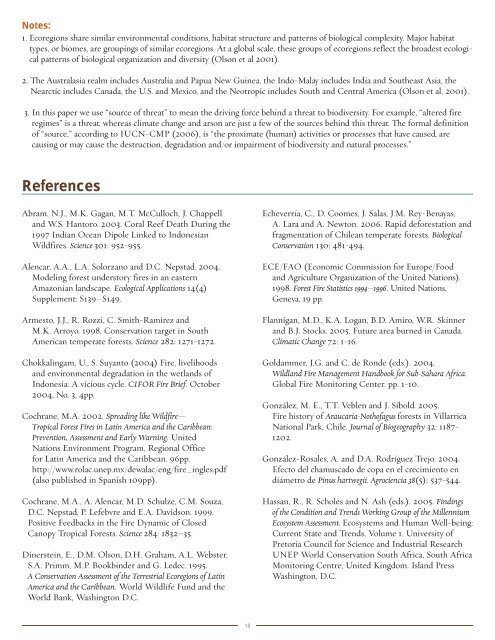Threats and Strategies for Global Biodiversity Conservation
Threats and Strategies for Global Biodiversity Conservation
Threats and Strategies for Global Biodiversity Conservation
Create successful ePaper yourself
Turn your PDF publications into a flip-book with our unique Google optimized e-Paper software.
Notes:1. Ecoregions share similar environmental conditions, habitat structure <strong>and</strong> patterns of biological complexity. Major habitattypes, or biomes, are groupings of similar ecoregions. At a global scale, these groups of ecoregions reflect the broadest ecologicalpatterns of biological organization <strong>and</strong> diversity (Olson et al 2001).2. The Australasia realm includes Australia <strong>and</strong> Papua New Guinea, the Indo-Malay includes India <strong>and</strong> Southeast Asia, theNearctic includes Canada, the U.S. <strong>and</strong> Mexico, <strong>and</strong> the Neotropic includes South <strong>and</strong> Central America (Olson et al. 2001).3. In this paper we use “source of threat” to mean the driving <strong>for</strong>ce behind a threat to biodiversity. For example, “altered fireregimes” is a threat, whereas climate change <strong>and</strong> arson are just a few of the sources behind this threat. The <strong>for</strong>mal definitionof “source,” according to IUCN-CMP (2006), is “the proximate (human) activities or processes that have caused, arecausing or may cause the destruction, degradation <strong>and</strong>/or impairment of biodiversity <strong>and</strong> natural processes.”ReferencesAbram, N.J., M.K. Gagan, M.T. McCulloch, J. Chappell<strong>and</strong> W.S. Hantoro. 2003. Coral Reef Death During the1997 Indian Ocean Dipole Linked to IndonesianWildfires. Science 301: 952-955.Alencar, A.A., L.A. Solorzano <strong>and</strong> D.C. Nepstad. 2004.Modeling <strong>for</strong>est understory fires in an easternAmazonian l<strong>and</strong>scape. Ecological Applications 14(4)Supplement: S139–S149.Armesto, J.J., R. Rozzi, C. Smith-Ramirez <strong>and</strong>M.K. Arroyo. 1998. <strong>Conservation</strong> target in SouthAmerican temperate <strong>for</strong>ests. Science 282: 1271-1272.Chokkalingam, U., S. Suyanto (2004) Fire, livelihoods<strong>and</strong> environmental degradation in the wetl<strong>and</strong>s ofIndonesia: A vicious cycle. CIFOR Fire Brief. October2004, No. 3, 4pp.Cochrane, M.A. 2002. Spreading like Wildfire—Tropical Forest Fires in Latin America <strong>and</strong> the Caribbean:Prevention, Assessment <strong>and</strong> Early Warning. UnitedNations Environment Program, Regional Office<strong>for</strong> Latin America <strong>and</strong> the Caribbean. 96pp.http://www.rolac.unep.mx/dewalac/eng/fire_ingles.pdf(also published in Spanish 109pp).Cochrane, M.A., A. Alencar, M.D. Schulze, C.M. Souza,D.C. Nepstad, P. Lefebvre <strong>and</strong> E.A. Davidson. 1999.Positive Feedbacks in the Fire Dynamic of ClosedCanopy Tropical Forests. Science 284: 1832–35.Dinerstein, E., D.M. Olson, D.H. Graham, A.L. Webster,S.A. Primm, M.P. Bookbinder <strong>and</strong> G. Ledec. 1995.A <strong>Conservation</strong> Assessment of the Terrestrial Ecoregions of LatinAmerica <strong>and</strong> the Caribbean. World Wildlife Fund <strong>and</strong> theWorld Bank, Washington D.C.Echeverría, C., D. Coomes, J. Salas, J.M. Rey-Benayas,A. Lara <strong>and</strong> A. Newton. 2006. Rapid de<strong>for</strong>estation <strong>and</strong>fragmentation of Chilean temperate <strong>for</strong>ests. Biological<strong>Conservation</strong> 130: 481-494.ECE/FAO (Economic Commission <strong>for</strong> Europe/Food<strong>and</strong> Agriculture Organization of the United Nations).1998. Forest Fire Statistics 1994–1996. United Nations,Geneva, 19 pp.Flannigan, M.D., K.A. Logan, B.D. Amiro, W.R. Skinner<strong>and</strong> B.J. Stocks. 2005. Future area burned in Canada.Climatic Change 72: 1-16.Goldammer, J.G. <strong>and</strong> C. de Ronde (eds.). 2004.Wildl<strong>and</strong> Fire Management H<strong>and</strong>book <strong>for</strong> Sub-Sahara Africa.<strong>Global</strong> Fire Monitoring Center. pp. 1-10.González, M. E., T.T. Veblen <strong>and</strong> J. Sibold. 2005.Fire history of Araucaria-Nothofagus <strong>for</strong>ests in VillarricaNational Park, Chile. Journal of Biogeography 32: 1187-1202.González-Rosales, A. <strong>and</strong> D.A. Rodríguez Trejo. 2004.Efecto del chamuscado de copa en el crecimiento endiámetro de Pinus hartwegii. Agrociencia 38(5): 537-544.Hassan, R., R. Scholes <strong>and</strong> N. Ash (eds.). 2005. Findingsof the Condition <strong>and</strong> Trends Working Group of the MillenniumEcosystem Assessment. Ecosystems <strong>and</strong> Human Well-being:Current State <strong>and</strong> Trends, Volume 1. University ofPretoria Council <strong>for</strong> Science <strong>and</strong> Industrial ResearchUNEP World <strong>Conservation</strong> South Africa, South AfricaMonitoring Centre, United Kingdom. Isl<strong>and</strong> PressWashington, D.C.18
















